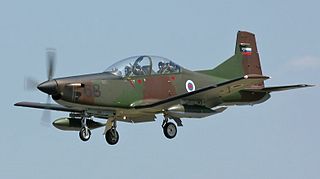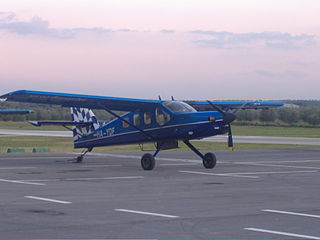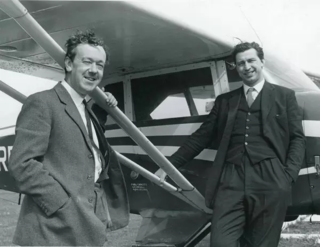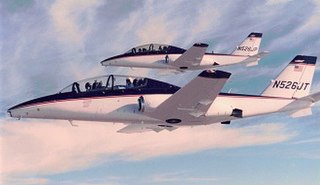
The Pilatus PC-7 Turbo Trainer is a low-wing tandem-seat training aircraft, designed and manufactured in Switzerland by Pilatus Aircraft. The aircraft is capable of all basic training functions, including aerobatics, instrument, tactical, and night flying.

The Short Tucano is a two-seat turboprop basic trainer built by Short Brothers in Belfast, Northern Ireland. It is a licence-built version of the Brazilian Embraer EMB 312 Tucano.

The Pilatus PC-6 Porter is a single-engined STOL utility aircraft designed by Pilatus Aircraft of Switzerland. First flown in 1959, the PC-6 was produced at Pilatus Flugzeugwerke in Stans, Switzerland. It has been built in both piston engine- and turboprop-powered versions, and was produced under licence for a time by Fairchild Hiller in the United States. After 604 deliveries in 63 years, Pilatus ended production in 2022.

The Pilatus PC-9 is a single-engine, low-wing tandem-seat turboprop training aircraft manufactured by Pilatus Aircraft of Switzerland. Designed as a more powerful evolution of the Pilatus PC-7, the PC-9's first flight was made in May 1984 after which certification was achieved in September 1985. After this, the first production orders for the type were received from the Royal Saudi Air Force, with deliveries commencing in 1985. Since then, more than 250 airframes have been produced across five different variants, and the type is employed by a number of military and civilian operators around the world, including the Swiss Air Force, Croatian Air Force, Royal Thai Air Force and the Irish Air Corps

The Valmet L-70 Vinka is a Finnish-designed piston-powered military basic trainer aircraft of the 1970s. A production run of 30 aircraft were built for the Finnish Air Force in the early 1980s, and although the type was not exported, it formed the basis of the turboprop-powered Aermacchi M-290 RediGO.
The IAR-825 Triumf is a Romanian-designed tandem multirole trainer aircraft based on the IAR-823 built for the Romanian Air Force. The aircraft is roughly in the same class with the Brazilian EMBRAER Tucano. The IAR-825 is equipped with the Canadian Pratt & Whitney Canada PT6 turboprop engine. The type's first flight took place on the 12 June 1982.

The Piper PA-48 Enforcer is an American turboprop-powered light close air support aircraft built by Piper in the 1970s. It is a development of the World War II-era North American P-51 Mustang fighter. The Enforcer concept was originally created and flown as the Cavalier Mustang by David Lindsay, owner of Cavalier Aircraft, in response to the United States Air Force PAVE COIN program, but Cavalier did not have the manufacturing abilities to mass-produce the Enforcer, so the program was sold to Piper by Lindsay in 1970.

The PZL 130 Orlik is a Polish turboprop, single engine, two seat trainer aircraft.

ENAER T-35 Pillán is a Chilean propeller-driven basic trainer aircraft. The student and the instructor sit in tandem. Production ceased in 1991 after 7 years but restarted briefly in 1998.
The AAC Wamira was a turboprop military trainer aircraft, designed for the Royal Australian Air Force (RAAF) by the Australian Aircraft Consortium (AAC). The project was cancelled shortly before the first prototype was completed.

The Fuji T-7 is a Japanese primary trainer aircraft built by Fuji Heavy Industries for the Japan Air Self-Defense Force. A development of Fuji's earlier T-3 trainer, it is a single-engined monoplane powered by a turboprop engine.

The Technoavia SM92 Finist is STOL utility aircraft, designed by the Russian company Technoavia which first flew on the 28 December 1993. It is built at the Smolensk Aviation Plant.

The NAC Fieldmaster was a British agricultural aircraft of the 1980s. A turboprop powered single-engined monoplane, it was built in small numbers and used both as a cropsprayer and a firefighting aircraft.

The NAC-1 Freelance, originally the BN-3 Nymph, is a British four-seat touring monoplane.

Nigel Desmond Norman, was an aircraft designer and aviation pioneer. Norman co-founded Britten-Norman in 1954, was appointed a Commander of the Order of the British Empire in 1970, and served as chairman and managing director of AeroNorTec (1988–2002). With his longtime friend and business partner John Britten, he also designed, built, and sailed racing yachts, as well as a series of air cushion vehicles and crop spraying equipment. He died of a heart attack at age 73 in 2002.

The Cessna 526 CitationJet was a twinjet trainer candidate for the United States Joint Primary Aircraft Training System proposed by Cessna. It was a twin-engined, tandem seat aircraft, based on the Cessna CitationJet executive aircraft. However, it was unsuccessful, with only two prototypes built.

The HAL HTT-40 is an Indian training aircraft designed and built by Hindustan Aeronautics Limited (HAL). It will replace the Indian Air Force's retired HPT-32 Deepak as a basic trainer.

The UTVA Kobac was a prototype Serbian single-engine, low-wing tandem-seat turboprop training/light attack aircraft manufactured by Pančevo based UTVA Aviation Industry, and designed by the Military Technical Institute. Revealed as a mockup on 2 September 2012 during the Batajnica 2012 Air Show, the aircraft's first flight was planned for 2013, but was never realized.
The Jaffe/Swearingen SA-32T is a prototype American turboprop- powered training aircraft with side-by-side seating. A single example was built in the late 1980s, but no production followed.

The Diamond DART is a series of tandem, two-seat civilian and military turboprop trainers manufactured by Austrian Diamond Aircraft, "DART" meaning Diamond Aircraft Reconnaissance Trainer.

















